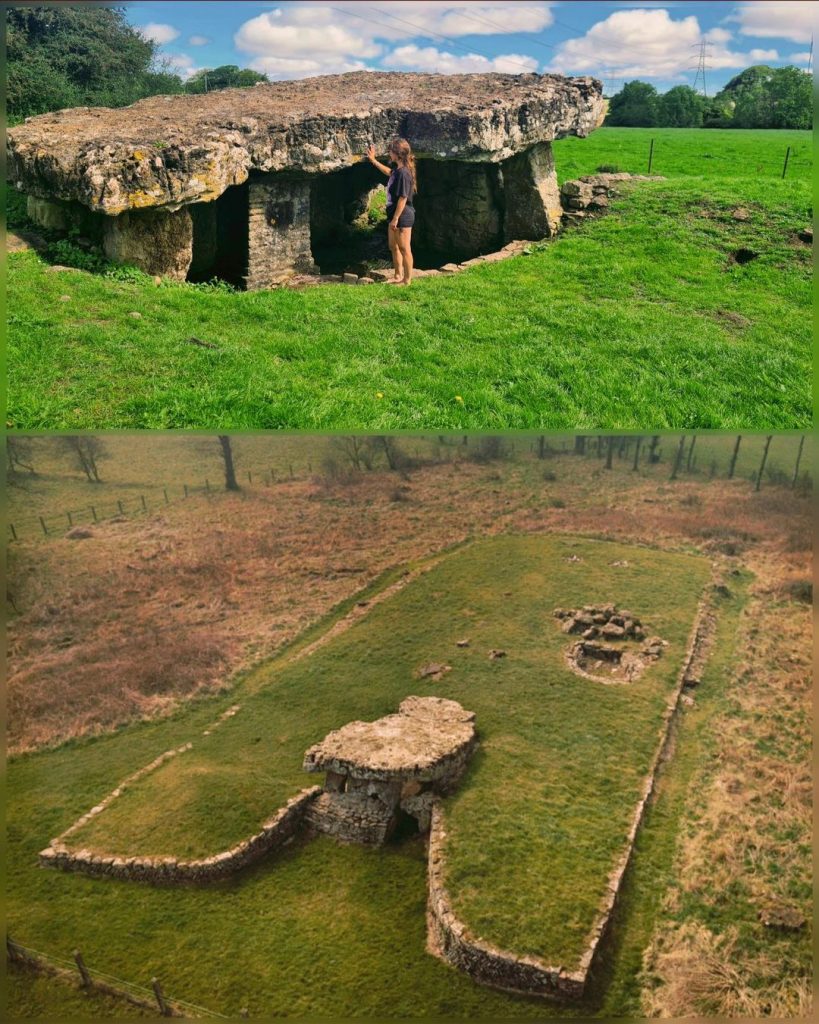Tinkinswood, located just west of Cardiff, Wales, is one of Britain’s most ancient and remarkable prehistoric burial sites, dating back over 6,000 years to the Neolithic era. Renowned for its sprawling chambered cairn and its colossal capstone—estimated to weigh around 40 tons and among the largest in Europe—this site holds immense historical and spiritual significance. The massive stone slab, which serves as the roof of a communal burial chamber, highlights the ingenuity and dedication of early societies, as well as the cultural importance of Tinkinswood in Neolithic Wales.

Tinkinswood served a dual purpose for the region’s ancient inhabitants, functioning both as a burial ground and a ceremonial center. Archaeological excavations have uncovered human remains inside the chamber, along with pottery fragments and flint tools, suggesting that this site was a focal point for rituals and communal gatherings. Some theories propose that Tinkinswood was also used to observe seasonal events such as solstices, underscoring the spiritual reverence early societies had for nature. These findings paint a vivid picture of a community deeply connected to its environment and united by shared traditions and beliefs.
Adding to its allure are the mystical legends and folklore that surround Tinkinswood. Local tales warn of eerie consequences for those who dare to spend the night there, particularly on the eve of certain holidays like May Day. According to these stories, individuals who do so might either lose their sanity or gain an extraordinary gift for poetry. Such folklore reflects a deep-seated historical belief in the power and mystery of ancient burial sites, imbuing Tinkinswood with an almost supernatural aura that continues to captivate the imagination.
The construction of Tinkinswood is a testament to the exceptional ingenuity of Neolithic builders. Despite lacking metal tools, these early engineers created a monument that has endured for millennia. The massive capstone and surrounding stones forming the cairn were likely transported and positioned using only rudimentary tools, wooden rollers, and significant communal effort. This feat of engineering showcases the social organization, cooperation, and innovative problem-solving skills of early Welsh societies. It also demonstrates the value they placed on creating enduring structures that served both practical and spiritual purposes.
Today, Tinkinswood remains an enduring symbol of prehistoric life and ingenuity. As one of Britain’s most evocative ancient monuments, it offers modern visitors a rare glimpse into the spiritual, social, and technological lives of Neolithic communities. The site illustrates how early societies commemorated their dead, celebrated their connection to the land, and maintained traditions that fostered a sense of belonging and continuity.
Beyond its historical significance, Tinkinswood is a place of reflection and quiet contemplation. Its tranquil surroundings and the enduring mysteries of its construction inspire awe and curiosity, bridging the gap between the present and the distant past. Visitors can explore the site and imagine the lives of those who once gathered here for rituals, burials, and perhaps even celestial observations. The legends and lore that persist further enrich this connection, offering a window into how ancient people perceived and honored the world around them.
The legacy of Tinkinswood is a reminder of the profound impact ancient societies had on shaping the cultural and spiritual landscape of Britain. It stands as a monument to their resilience, creativity, and the enduring human desire to connect with something greater than ourselves. Even today, the site’s immense capstone and carefully arranged stones continue to evoke wonder, reflecting the skill and determination of its builders.
Tinkinswood’s place in Welsh history is complemented by its connection to broader Neolithic traditions found throughout Europe. The site belongs to a larger network of dolmens and burial chambers that once dotted the landscape, each serving as a testament to the shared cultural practices and engineering achievements of the time. These structures not only honored the dead but also served as communal spaces that brought people together, reinforcing social bonds and a collective sense of purpose.

While much about Tinkinswood remains shrouded in mystery, ongoing research and exploration continue to shed light on its role in prehistoric life. The discoveries made here contribute to our understanding of how ancient communities lived, worshiped, and celebrated their connection to the natural world. Every artifact and architectural detail uncovered at Tinkinswood offers a new piece of the puzzle, helping us reconstruct a clearer picture of this remarkable chapter in human history.
For those who visit today, Tinkinswood offers more than just a glimpse into the past—it provides an opportunity to connect with the enduring legacy of an ancient people whose ingenuity and traditions still inspire us. It is a place where history, legend, and nature converge, inviting us to reflect on the timeless human quest to understand our place in the universe.
As one of the most significant prehistoric monuments in Britain, Tinkinswood continues to captivate scholars, visitors, and storytellers alike. Its legends, architectural marvels, and spiritual significance ensure its place as a cherished link between the present and the enigmatic past of ancient Wales. Whether viewed as a historical treasure, a place of contemplation, or a site of ancient mystery, Tinkinswood remains a powerful testament to the ingenuity and spirit of those who came before us.





